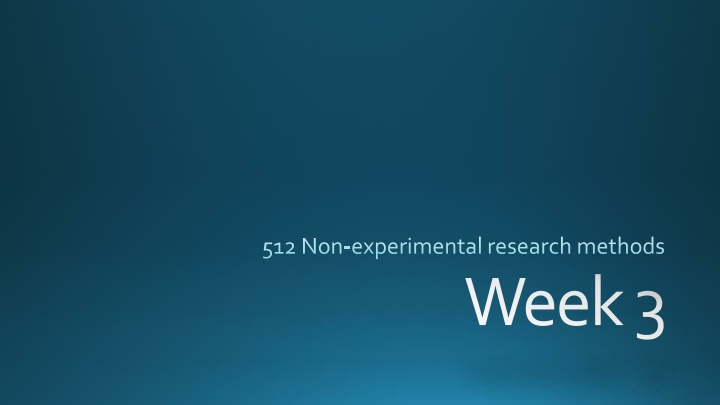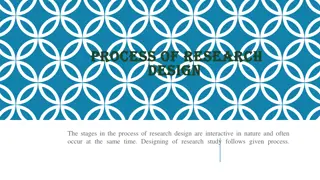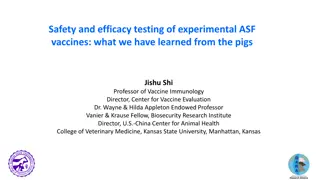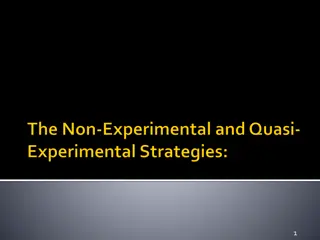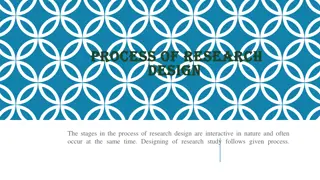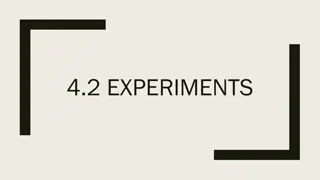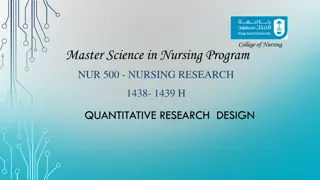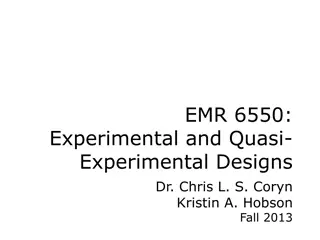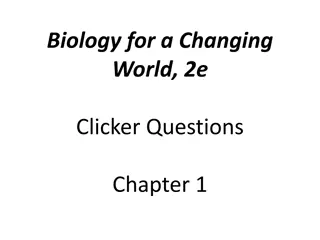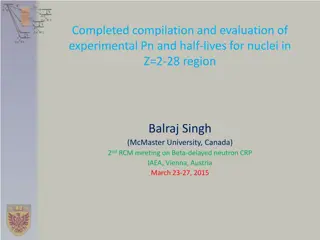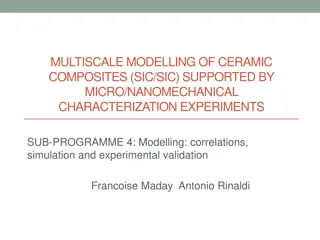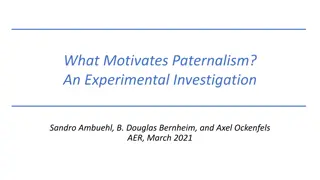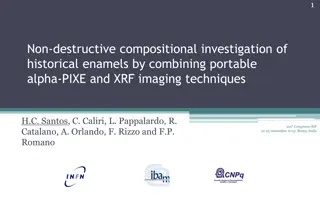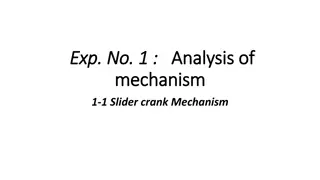Non-Experimental Research Methods: Understanding Types & Techniques
Experimentation in research involves controlled settings and manipulation of variables to establish cause-and-effect relationships. On the other hand, non-experimental methods like observational studies, surveys, and archival research do not involve direct manipulation and control. This comparison explores the strengths and weaknesses of both approaches, highlighting the importance of considering real-world applicability and limitations in experimental design.
Download Presentation

Please find below an Image/Link to download the presentation.
The content on the website is provided AS IS for your information and personal use only. It may not be sold, licensed, or shared on other websites without obtaining consent from the author.If you encounter any issues during the download, it is possible that the publisher has removed the file from their server.
You are allowed to download the files provided on this website for personal or commercial use, subject to the condition that they are used lawfully. All files are the property of their respective owners.
The content on the website is provided AS IS for your information and personal use only. It may not be sold, licensed, or shared on other websites without obtaining consent from the author.
E N D
Presentation Transcript
What is experiment? Random sampling: a sampling method in which each member of a set has independent chances to be selected (the notion of "equal chances" is a theoretical ideal mentioned by many textbooks, but there are always some hidden bias or disposition in the real world). Randomization: randomly assign subjects into the control group and the treatment group. Experimenter manipulation: directly manipulate variables to test cause- and-effect relationships e.g. alter the amount of drug given to the patients. Experimenter control: involves control of all other extraneous variables or conditions that might have an impact on the dependent variables.
What is non-experiment? You have none of the above. Is there a relationship between IQ and resiliency? Ex post facto (after the fact) Observational study Causal-comparative (misnomer) Survey research Archival research
Is experimentation the Gold standard? Canadian Task Force for Preventive Health Care (2003)
Is that true? Amanda conducted an experiment in a controlled setting whereas Crystal did an non-experimental study in a naturalistic setting. Amanda said to Crystal, Ha! Ha! My thesis is an experimental study. I can draw a firm causal conclusion but you cannot. I am the best!
Gaps between the real world & the lab Essock et al. (2003) observed the discrepancy between the "real world" and the lab settings. Many drug treatment studies last about four to eight weeks only. Short-term drug tests may cost less to implement, but usually these studies do not yield the statistical significance that is found in long-term experiments.
Pepsi Challenge In experimental settings, most participants prefer Pepsi to Coke. However, this so-called "Pepsi Challenge" is based on the unrealistic "sip test" method. Most tasters would favor the sweeter of two beverages when they make a single sip only, but the result is reversed when the entire can or bottle is consumed
Is that true? Jessica conducted an experiment with 50 subjects recruited from APU. Ashley downloaded an archival data set from the United Nations. The sample is 100,000 but the data are observational (non-experimental). Every member nation reported to the UN about what had happened in its society. Jessica said to Ashley, Ha! Ha! My thesis is an experimental study and yours is not. My conclusion is more trustworthy than yours.
Paradigm shift: The era of Big Data Today many agencies and corporations make decisions based on big data analytics. Every day 2.5 Quintillion* bytes of data are created. Everyone creates data. Everything you do leaves a trace. Extremely large data sets that may be analyzed computationally to reveal patterns, trends, and associations, especially relating to human behavior and interactions. * a thousand raised to the power of six (10^18)
SAS Certification Program SAS Global Academic Program You don t need to take the external SAS exam. The joint-certificate is awarded after completing the program. Peers: Purdue University, Texas A & M, University of Denver, UC-San Diego, Oklahoma State University
SAS Certification Program SAS Global Certification Program You need to pass the SAS exam to be certified Designed for individuals who can manipulate and gain insights from big datawith a variety of SAS and open source tools, make business recommendations with complex machine learning models, and then deploy models at scale using the flexible, robust SAS environment What is Big data? What is machine learning? The sample is partitioned into subsets. Some subsets are used for training. The computer algorithm can learn from previous models to improve subsequent models.
Basic JMP Contextualmenu and dynamicgraphic The output is not frozen (done). You can determine what to do next by looking at the output. You can ask what-if questions by exploring alternate approaches. Please do not try to follow what I do when I am doing a demo. You will have a chance to practice.
Anscombedata Non-linear fit
Anscombedata Remove outlier
Anscombedata Robust fit Robust against outliers
Input JMP SAS HTML SPSS Import Excel Invoke JMP from Excel (Window only)
Three levels of measurement in practice In theory there are four levels of measurement. In computation there is no difference between interval and ratio No matter whether the scale has an absolute or not, it won t affect the statistical procedure.
Output Report with embedded data: JRP Script PowerPoint PDF PNG Interactive HTML RTF MS Word Many others Windows: Save as Mac: Save as Export Copy and paste
SAS Basic Data steps Data one; set thesis.anxiety; Data two; set anxiety; /* assume the data set anxiety is in the work library Procedure steps; PROC MEANS; varX1 X2 Y; run; PROC REG; model y = X1 X2; run;
Input: MyFolder Drag and drop
Output Specify journal style in Output Delivery System (ODS) SAS on demand: Email or save as/print as SAS UE: Save as
